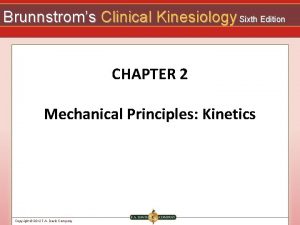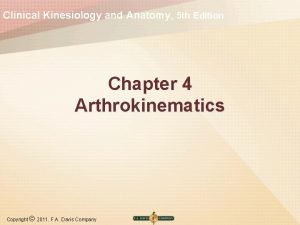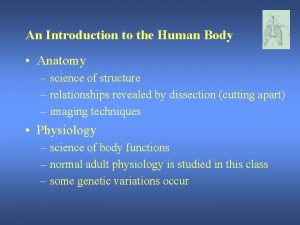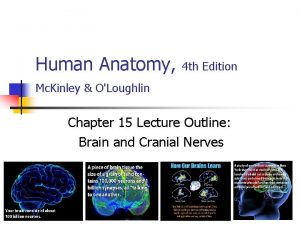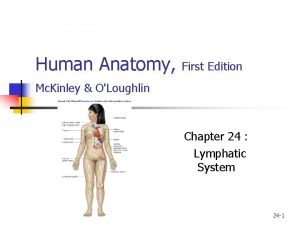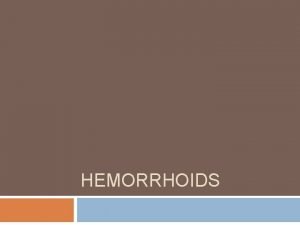Human Anatomy 4 th Edition Mc Kinley OLoughlin







































- Slides: 39

Human Anatomy, 4 th Edition Mc. Kinley & O'Loughlin Chapter 14 Lecture Outline: Nervous Tissue 1

The Nervous System n n The nervous system is the body’s primary communication and control system. The nervous system can be divided according to structural and functional categories. 14 -2

Nervous System: Structural Organization Structural subdivisions of the nervous system: • Central nervous system (CNS) • brain and spinal cord • Peripheral nervous system (PNS) • cranial nerves (nerves that extend from the brain) • spinal nerves (nerves that extend from the spinal cord) • ganglia (clusters of neuron cell bodies located outside the CNS) 14 -3

Nervous System: Functional Organization Functional divisions of the nervous system: • Sensory division — receives sensory information (input) from receptors and transmits this information to the CNS. • Motor (or efferent) division — transmits motor impulses (output) from the CNS to muscles or glands. 14 -4

The sensory division is subdivided into two Sensory Division components: • Somatic sensory components are the general somatic senses—touch, pain, pressure, vibration, temperature, and proprioception. • Visceral sensory components transmit nerve impulses from blood vessels and viscera to the CNS. The visceral senses primarily include temperature and stretch (of the organ wall). 14 -5

The motor division is subdivided into two components: • The somatic motor component (somatic nervous system; SNS) conducts nerve impulses from the CNS to skeletal muscles. • also known as the voluntary nervous system • The autonomic motor component (autonomic nervous system; ANS) innervates internal organs, regulates smooth muscle, cardiac muscle, and glands. • also known as the visceral motor system or involuntary nervous system 14 -6

Nerve Cells • Two distinct cell types form nervous tissue. - Neurons, which are excitable cells that initiate and transmit nerve impulses - Glial cells, which are nonexcitable cells that support and protect the neurons 14 -7

Characteristics of Neurons • Neurons have a high metabolic rate. • Neurons have extreme longevity. • Neurons typically are non-mitotic. 14 -8

Neuron Structure • Neurons come in all shapes and sizes, but all neurons share certain basic structural features. • A typical neuron has a cell body, dendrites, and axons. 14 -9

Neuron Structure – Cell Body • The cell body serves as the neuron’s control center and is responsible for receiving, integrating, and sending nerve impulses. • Neurotransmitters like acetylcholine are synthesized in the cell body 14 -10

Neuron Structure – Dendrites • Dendrites tend to be shorter, smaller processes that branch off the cell body. • Some neurons have only one dendrite, while others have many. • Dendrites conduct nerve impulses toward the cell body; they receive input and then transfer it to the cell body for processing. • The more dendrites a neuron has, the more nerve impulses that neuron can receive from other cells. 14 -11

Neuron Structure – Axon • The larger, typically longer nerve cell process emanating from the cell body is the axon, sometimes called a nerve fiber. • Most neurons have only one axon. • The axon transmits a nerve impulse away from the cell body toward another cell. 14 -12

13

a) Regions of neuron b) Structural components of a neuron 14

Classifications of Neurons • Neurons vary widely in morphology and location. • They can be classified according to either their structure or their function. • Neurons can be classified according to the number of processes extending from the cell body. • unipolar neuron has a single process • bipolar neurons have two processes • multipolar neurons have three or more processes 14 -15

Interneurons • Interneurons, or association neurons, lie entirely within the CNS and are multipolar. • They receive nerve impulses from many other neurons and carry out the integrative function of the nervous system. • Thus, interneurons facilitate communication between sensory and motor neurons. 14 -16

17

Glial Cells • Sometimes referred to as neuroglia, occur within both the CNS and the PNS. • Glial cells are smaller and capable of mitosis. • Glial cells do not transmit nerve impulses. • Glial cells physically protect and help nourish neurons, and provide an organized, supporting framework for all the nervous tissue. • Glial cells far outnumber neurons. • Glial cells account for roughly half the volume of the nervous system. 14 -18

19

20

21

Glial Cells of the CNS • Astrocytes exhibit a starlike shape due to projections from their surface. • Astrocytes are the most abundant glial cells in the CNS, and they constitute over 90% of the tissue in some areas of the brain. • Help form the blood-brain barrier (BBB) that strictly controls substances entering the nervous tissue in the brain from the bloodstream. • Regulate tissue fluid composition. 14 -22

Functions of Glial Cells • Forming a structural network. • Replacing damaged neurons. • Assisting neuronal development. 14 -23

Myelination • Neurolemmocytes also called Schwann cells, are associated with PNS axons and are responsible for myelinating PNS axons. • Myelination is the process by which part of an axon is wrapped with a myelin sheath, a protective fatty coating that gives it glossy-white appearance. • The myelin sheath supports, protects, and insulates an axon. 14 -24

Myelination • No change in voltage can occur across the membrane in the insulated portion of an axon. • In the PNS, myelin sheaths form from neurolemmocytes. • In the CNS, they form from oligodendrocytes. 14 -25

• In the CNS, they form from oligodendrocytes. • In the PNS, myelin sheaths form from neurolemmocytes. 26

Myelinated vs. Unmyelinated Axons • In a myelinated axon, the nerve impulse “jumps” from neurofibril node to neurofibril node and is known as saltatory conduction. • In an unmyelinated axon, the nerve impulse must travel the entire length of the axon, a process called continuous conduction. • A myelinated axon produces a faster nerve impulse. 14 -27

Myelinated vs. Unmyelinated Axons • In an unmyelinated axon, a nerve impulse takes longer to reach the end of the axon. • A myelinated axon also requires less energy (ATP) than does an unmyelinated axon. • Using continuous conduction, unmyelinated axons conduct nerve impulses from pain stimuli. 14 -28

Regeneration of PNS Axons • PNS axons are vulnerable to cuts, crushing injuries, and other trauma. • A damaged axon can regenerate, however, if at least some neurilemma remains. • PNS axon regeneration depends upon three factors. • the amount of damage • neurolemmocyte secretion of nerve growth factors to stimulate outgrowth of severed axons • the distance between the site of the damaged axon and the effector organ • https: //www. youtube. com/watch? v=Ua. Ku. Y 1 WYJc. A 14 -29

30

31

Structure of a Nerve • A nerve is a cable-like bundle of parallel axons. • Like a muscle, a nerve has three successive connective tissue wrappings. - endoneurium - a delicate layer of loose connective tissue - perineurium - a cellular and fibrous connective tissue layer that wraps groups of axons into bundles called fascicles - epineurium - a superficial connective tissue covering • This thick layer of dense irregular fibrous connective tissue encloses the entire nerve, providing both support and protection 14 -32

33

Nerves • Nerves are a component of the peripheral nervous system. • Sensory (afferent) nerves convey sensory information to the CNS. • Motor (efferent) nerves convey motor impulses from the CNS to the muscles and glands. • Axons terminate as they contact other neurons, muscle cells, or gland cells. • An axon transmits a nerve impulse at a specialized junction with another neuron called synapse. 14 -34

Synapses • Presynaptic neurons transmit nerve impulses along their axonal membranes toward a synapse. • Postsynaptic neurons conduct nerve impulses through their dendritic and cell body membranes away from the synapse. • Axons may establish synaptic contacts with any portion of the surface of another neuron, except those regions that are myelinated. • Link http: //highered. mheducation. co m/sites/0072495855/student_vi ew 0/chapter 14/animation__the _nerve_impulse. html 14 -35

36

Electrical Synapses • Electrical synapses are not very common in mammals. • In humans, these synapses occur primarily between smooth muscle cells where quick, uniform innervation is essential. • Electrical synapses are also located in cardiac muscle. 14 -37

Chemical Synapses • The most numerous type of synapse is the chemical synapse. • It facilitates most of the interactions between neurons and all communications between neurons and effectors. • At these junctions, the presynaptic membrane releases a signaling molecule called a neurotransmitter, such as acetylcholine (ACh). • Other types of neurons use other neurotransmitters. • Link • http: //highered. mheducation. com/ sites/0072495855/student_view 0/c hapter 14/animation__chemical_sy napse__quiz_1_. html 14 -38

Neurotransmitters • Are released only from the plasma membrane of the presynaptic cell. • It then binds to receptor proteins found only on the plasma membrane of the postsynaptic cell. • A unidirectional flow of information and communication takes place. • Two factors influence the rate of conduction of the impulse: the axon’s diameter and the presence (or absence) of a myelin sheath. 14 -39
 Dr kinley berger
Dr kinley berger El vial de kinley
El vial de kinley Human anatomy and physiology seventh edition marieb
Human anatomy and physiology seventh edition marieb Uterus perimetrium
Uterus perimetrium Anatomy and physiology ninth edition
Anatomy and physiology ninth edition Human anatomy fifth edition
Human anatomy fifth edition Human anatomy fifth edition
Human anatomy fifth edition Using mis (10th edition) 10th edition
Using mis (10th edition) 10th edition Report
Report Brunnstrom's clinical kinesiology 6th edition
Brunnstrom's clinical kinesiology 6th edition Clinical kinesiology and anatomy 6th edition
Clinical kinesiology and anatomy 6th edition Understanding human differences 5th edition
Understanding human differences 5th edition Human resource management lecture chapter 1
Human resource management lecture chapter 1 Hr proficiencies
Hr proficiencies Human genetics concepts and applications 10th edition
Human genetics concepts and applications 10th edition International human resource management dowling 6th edition
International human resource management dowling 6th edition Adler and rodman 2006
Adler and rodman 2006 The art of being human 11th edition
The art of being human 11th edition Performance appraisal in human resource management
Performance appraisal in human resource management Understanding human communication 14th edition
Understanding human communication 14th edition Trends shaping hrm
Trends shaping hrm Chapter 1 introduction to human anatomy and physiology
Chapter 1 introduction to human anatomy and physiology Anatomy of the human heart
Anatomy of the human heart Human anatomy vocabulary
Human anatomy vocabulary Holes essential of human anatomy and physiology
Holes essential of human anatomy and physiology Chapter 1 introduction to human anatomy and physiology
Chapter 1 introduction to human anatomy and physiology Parturition
Parturition The right hypochondriac region is in the ruq
The right hypochondriac region is in the ruq Chapter 2 human reproductive anatomy and physiology
Chapter 2 human reproductive anatomy and physiology Figure 16-7 is a sectional view of the ovary
Figure 16-7 is a sectional view of the ovary Human anatomy terminology
Human anatomy terminology How wide is the esophagus
How wide is the esophagus Human anatomy terms
Human anatomy terms Human anatomy slide
Human anatomy slide Human vs non human bones
Human vs non human bones Human needs and human development chapter 8
Human needs and human development chapter 8 Chapter 8 human needs and human development
Chapter 8 human needs and human development Human development index definition ap human geography
Human development index definition ap human geography Human and non human nouns
Human and non human nouns A world of art 8th edition pdf
A world of art 8th edition pdf









